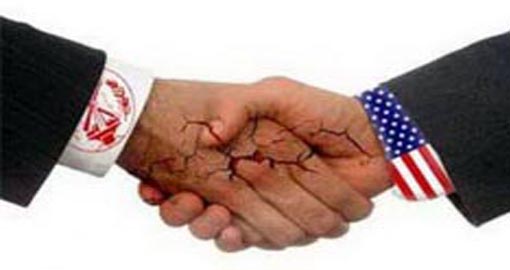Though the latest unrest in Iran about the rising prices of fuel started as a purely internal issue, Washington quickly inserted itself into the dispute, seeking to advance its agenda of toppling the government in Tehran.
Gas prices doubled or even tripled over the weekend, following a decision by the government to cut fuel subsidies and redirect those funds into other social programs. Widespread protests across Iran have escalated into riots in some places, with reports of half a dozen deaths and multiple injuries. The authorities have blamed the US for fueling the unrest and apparently shut down the internet in response.
The official line coming out of Tehran seems to be that protests themselves are legitimate, but that the violence was the work of “a group of anarchists and saboteurs” which are “by no means in line with the conduct and behavior of the majority of the understanding and insightful Iranian people,” in the words of Foreign Ministry Spokesman Abbas Mousavi.
Another indication that the government recognizes the protests as legitimate was a sarcasm-laden segment about gas prices and inflation in general, which had no trouble airing on state TV.
“Our authorities make other really nice comparisons: Comparing our taxi fare w/ that of #NewYork, price of fuel w/ #London, price of rent w/ #Paris, price of gas w/ #Turkey but when it comes to wages they make a comparison w/ #Ethiopia. Otherwise, their comparisons are really gd.
— Ali Fathollah-Nejad (@AFathollahNejad) November 16, 2019
Washington is not even bothering to hide its glee. Over the weekend, as the protests heated up, Secretary of State Mike Pompeo retweeted a 2018 message to the “people of Iran,” telling them that the US “hears you… supports you… is with you.”
On Monday, the State Department tweeted out graphics accusing the government in Tehran of spending billions of dollars on “funding terrorism” instead of on social programs at home.
Iran’s President Rouhani raided $4.8 billion from the National Development Fund to pay for terrorism. pic.twitter.com/UWBPHZXQIr
— Department of State (@StateDept) November 18, 2019
That’s some irony, considering that Iran’s current predicament is almost entirely due to the US unilaterally shredding the 2015 nuclear deal and reimposing sanctions on Tehran – while threatening other countries to follow suit, or else. Pompeo himself said a year ago that Iran had a choice to submit or starve.
Mousavi brought that up on Sunday, arguing the people of Iran are “under pressure of the United States’ economic terrorism,” and rejecting Pompeo’s “hypocritical remarks” as lacking genuine sympathy.
Support for the protests by US-backed exiles such as MEK, who are angling for regime change in Tehran, will do little to dissuade those in Iran inclined to see Washington behind the violence.
Shiraz, south-central #Iran
“Down with dictator!”
Locals are continuing their protests over the latest gas price hikes & targeting senior regime figures.#IranProtestspic.twitter.com/c11ffSI8Rs— People’s Mojahedin Organization of Iran (PMOI/MEK) (@Mojahedineng) November 16, 2019
It is no secret that Washington has been opposed to the Islamic Republic ever since it overthrew the pro-US monarchy in the 1979 revolution. While it may have seemed that Trump’s hard line towards Tehran may have been driven by MEK fan John Bolton, the fact that nothing changed following Bolton’s dismissal in September suggests otherwise.
When Pompeo says the US “stands with the people of Iran,” it is hard to not notice that he also“stands with Venezuela” – in wanting regime change in Caracas, that is. Or that the Trump administration hailed the entirely undemocratic trampling of electoral results in Bolivia as a “significant moment for democracy” and “one step closer to a completely democratic, prosperous, and free Western Hemisphere.”
Rising gas prices were behind last month’s demonstrations in Ecuador, as well as the Yellow Vests movement in France that’s been going on for a year now. Chileans have been protesting for weeks over subway fare hikes – with two dozen reported deaths so far. Yet the US has not clamored for regime change in any of those places. Amnesty International has not been “horrified” or “alarmed” by any of them, as it is about Iran.
Compare and contrast the amount of coverage given to those protests with places whose governments Washington disapproves of: Hong Kong, Bolivia, Venezuela, Iran… Could it possibly be that the “who” and the “where” have a lot more to do with that than the “why”?
One of the overlooked but especially pernicious effects of US-backed “color revolutions” over the past 20 years has been to poison the well of genuine democracy and grassroots protests around the world. When media, NGOs, street protests and even elections are easily weaponized to either advance the cause of regime change, or delegitimize genuine social movements – depending solely on whether the US likes the country’s government or not – how does anyone know what is legitimate anymore?
So no, this is not just about the cost of gas at the pump.


